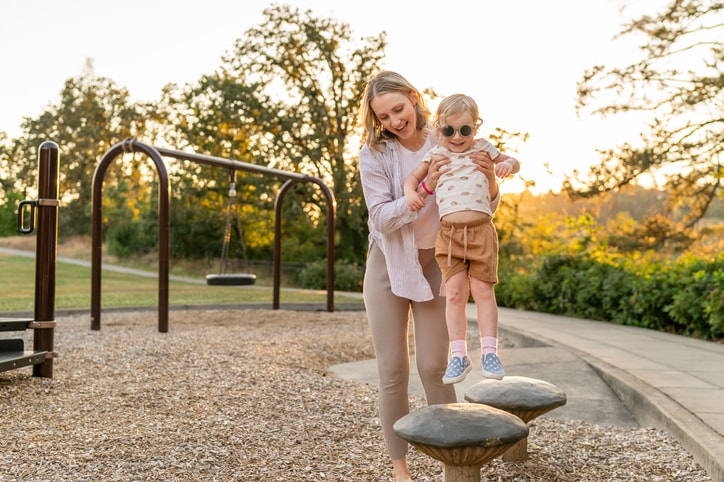When my husband left town for a week, leaving me to solo parent our 1-year-old daughter, I initially thought, “No problem, I can solo parent just fine!” It was the longest amount of time I’d been alone with her, but I figured I could handle it, especially since we had a part-time caregiver. Yet not 24 hours later, I looked like the frazzled mom from “Home Alone,” fumbling the morning routine and then frantically running around the house, nearly forgetting my kid in my rush out the door.
Our caregiver watched our child during the day, along with her own toddler. Sometimes her older child joined, too. As I’d drive to their place, trying to keep myself from speeding because I was running late, I’d think: how does she watch multiple kids by herself, so often and so cheerfully?
My kid’s caregiver inspires me
When I’d arrive at our caregiver’s house, the scene would be tranquil: toys sorted neatly into designated areas; some cute craft or game already underway. And, not for nothing, she would also appear impressively put-together. In contrast, I’d resigned myself to stained sweatpants most days. Sure, appearance may be a superficial thing to notice, but it can feel like it represents something deeper — like the extent to which someone’s in control of their life — and she seemed very much in control of hers.
Ultimately, though, it wasn’t any one thing about our caregiver that impressed me. Rather, it was my perception that she just genuinely loved being a caregiver. She didn’t resent the responsibility, or view it as an infringement on what she’d rather be doing. At that point, I couldn’t always say the same for myself.
Of course, I love my child, and most of the time, I love being a mom, too. For the first eight months of my daughter’s life, I’d stopped working to focus solely on parenting, and I felt grateful to be able to do so. But, then I started freelance writing, and I struggled to be as present for my child. My mind would wander to all the work in front of me, and my eyes would wander to the clock, calculating how much time until my husband or our caregiver could take over.
“Caregiving … is unending. There is no point at which you can just ‘check out.’ I have enormous respect for those, like our caregiver, who do it full-time with positivity and competence.”
I had (and have) no doubt that my job is easier than being a full-time caregiver. When I want a break for myself, I take it. When I have lunch, I’m not also feeding one or more people. Caregiving, in contrast, is unending. There is no point at which you can just “check out.” I have enormous respect for those, like our caregiver, who do it full-time with positivity and competence.
The parenting lessons I’ve learned from my child’s caregiver
Many months have passed since that week spent solo parenting my daughter, but our caregiver continues to inspire me. Here are a few of the lessons I’ve been reminded of since working with her.
1. Communicate well and often
I’m not great about checking in with people or looping everyone in on details. At times, the pressure to be in constant contact with people brings out an almost adolescent resistance within me. (Why must everyone know where I am at all times?!) I’ve sent my husband into a minor panic more than once by not responding to his texts for hours, and irritated relatives by not giving them sufficient details before they babysit.
Given my own shortcomings, I don’t expect hyper-diligent updates from other people, but our caregiver’s conscientious communication has been a pleasant surprise. She sends frequent texts and photos about what she and the kids are up to. Seeing my daughter holding hands with my caregiver’s son as they run through the park together is a true bright spot in my work days. It reassures me that our child is in good hands, and it helped build trust with her early on.
Our caregiver also keeps a journal where she logs meals, naps and activities. These insights are both sweet and practical, helping us keep track of any changes or unusual behavior. Seeing how nice it is to be on the other side of good communication, I now try to model the same level of consideration. I send photos to the extended family group chat more often. I check in with my husband more about my plans, and if he’s watching our child without me, I’ll fight my urge to ignore my phone, so I can see if he has a question. Taking a literal page from our caregiver’s journal, I also try to keep better track of our daughter’s behavior, and sometimes even write down notes, especially with regard to her health.
2. Get out and explore with your child
I sometimes joke that our child’s life is cooler is mine. In the past year, she’s been to a farm, a zoo, a science center, a children’s museum and about a dozen parks and playgrounds. Many times, our caregiver has taken the kids to a nearby gymnastics studio, where they have tons of padded space to run, jump and roam. It’s 10 minutes from our house, but it’d never occurred to me to take our child there before. It’s just so much easier to fall into the routines of staying home or going to the same park every day. I know how much work it is to get just one toddler out the door and to a new location where she has to be watched extra carefully. I cannot imagine doing this with two or three little ones — by myself.
Seeing our caregiver pull off so many outings made me realize we could do more, though. Her spirit of adventure and seemingly-high tolerance for inconvenience motivates me to get over my hang-ups about getting out with my child, and we’ve since copied several of her ideas. For instance, on a trip to New York City, I remembered that our caregiver frequently takes the kids to the library, so I was inspired to check out the one near us. Sure enough, there was a wonderful children’s section there. We’ve also gone to the gymnastics studio and the local farm, both of which were well worth the effort (on-the-go diaper changes and all).
3. Activities don’t have to be fancy to be meaningful and fun
At our caregiver’s home, the kids always seem to be doing creative activities. They splash in a water table, paint the windows with washable paint and make forts and obstacle courses out of pillows. By hearing about these different activities, I’ve gotten ideas for ways to pass the time in our own home, especially as our child has transitioned from a calm, easily-entertained infant to an energetic toddler.
“When I chase my daughter around our [pillow] fort, she squeals with delight, and I think of how grateful I am to our caregiver for giving us the idea.”
After hearing how much our child loves baking muffins and playing with toy food at our caregiver’s, I started giving her a bowl and spoon at home to make “soup,” and it’s become one of her favorite games. I even bought the same Nugget couch our caregiver has, so we can build our own pillow forts modeled off of those they create. When I chase my daughter around our fort, she squeals with delight, and I think of how grateful I am to our caregiver for giving us the idea.
4. The way we talk about our kids matters
When we first started working with our caregiver, I noticed the ways she talked about kids revealed an extra level of respect for them. For instance, when our daughter had a hard time going down for a nap (in other words, she was wailing and complaining), our caregiver would text that she “was a little sad.” It struck me as compassionate. Rather than saying that our daughter was fussy or even that she cried, saying “she was sad” centers our child’s feelings.
Given how exasperated I sometimes feel when I’m not able to get our child to sleep, hearing someone else describe the process with such tenderness reminds me to have more patience. Though I’ve never directly spoken harshly to my child (she’s only a baby, after all), I have spoken in pretty negative terms about her behavior. I’ve whined to my husband countless times that her waking in the middle of the night is driving me crazy, or that feeding her meals is tedious. Even if these comments are indirect and spoken to an adult, I believe that the way we talk can bleed into how we think, feel and behave, and I want to be more conscientious about that.
Intellectually, I know that children are hyper-sensitive to their parent’s feelings about them, and I don’t want my daughter to pick up on my impatience and blame herself. While I think venting can still be healthy, I try to remember our caregiver’s approach and respect my child at all times — not only when I talk to her, but also when I talk about her.
5. Having more caring adults around is a good thing
Before hiring a caregiver, I was a bit nervous about outsourcing child care. Now, I feel genuinely glad that our daughter is developing a relationship with another kind adult and her children. I’ve learned that a professional caregiver is so much more than just a person who keeps our child safe and fed while we work. Our caregiver gives our child enriching experiences she wouldn’t otherwise have, while showing us what it looks like to embrace caregiving to the fullest.
Her positive approach to child care reminds me of the expression, “You get what you put in.” So, if I catch myself having a moment of self-pity because I’m solo parenting or playing with Legos when I’d rather be lying on the couch scrolling Instagram, I think of my caregiver and the amount that she “puts in” to caring for my child. I put down my phone and whisk up my daughter for a little adventure. By the time we’re there, I’m enjoying it as much as she is.





